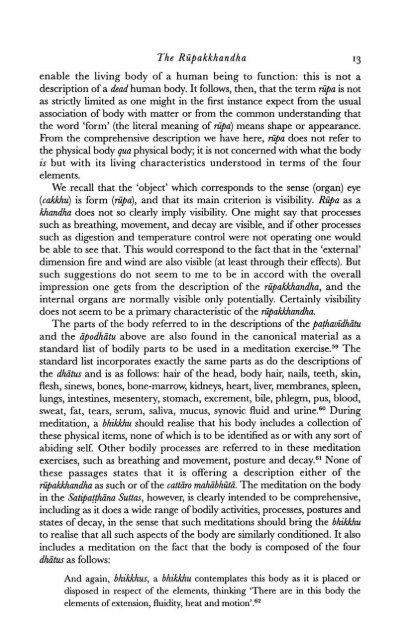Identity and Experience_Hamilton_1996
Identity and Experience_Hamilton_1996
Identity and Experience_Hamilton_1996
Create successful ePaper yourself
Turn your PDF publications into a flip-book with our unique Google optimized e-Paper software.
The Riipakkh<strong>and</strong>ha 13<br />
enable the living body of a human being to function: this is not a<br />
description of a dead human body. It follows, then, that the term rtipa is not<br />
as strictly limited as one might in the first instance expect from the usual<br />
association of body with matter or from the common underst<strong>and</strong>ing that<br />
the word 'form' (the literal meaning of rips) means shape or appearance.<br />
From the comprehensive description we have here, epa does not refer to<br />
the physical body qua physical body; it is not concerned with what the body<br />
is but with its living characteristics understood in terms of the four<br />
elements.<br />
We recall that the 'object' which corresponds to the sense (organ) eye<br />
(cakkhu) is form (rtipa), <strong>and</strong> that its main criterion is visibility. Ru'pa as a<br />
kh<strong>and</strong>ha does not so clearly imply visibility. One might say that processes<br />
such as breathing, movement, <strong>and</strong> decay are visible, <strong>and</strong> if other processes<br />
such as digestion <strong>and</strong> temperature control were not operating one would<br />
be able to see that. This would correspond to the fact that in the 'external'<br />
dimension fire <strong>and</strong> wind are also visible (at least through their effects). But<br />
such suggestions do not seem to me to be in accord with the overall<br />
impression one gets from the description of the riipakkh<strong>and</strong>ha, <strong>and</strong> the<br />
internal organs are normally visible only potentially. Certainly visibility<br />
does not seem to be a primary characteristic of the riipaWduzn&a.<br />
The parts of the body referred to in the descriptions of the pa{hautdha'tu<br />
<strong>and</strong> the cpodhatu above are also found in the canonical material as a<br />
st<strong>and</strong>ard list of bodily parts to be used in a meditation exercise.59 The<br />
st<strong>and</strong>ard list incorporates exactly the same parts as do the descriptions of<br />
the dhiitus <strong>and</strong> is as follows: hair of the head, body hair, nails, teeth, skin,<br />
flesh, sinews, bones, bone-marrow, kidneys, heart, liver, membranes, spleen,<br />
lungs, intestines, mesentery, stomach, excrement, bile, phlegm, pus, blood,<br />
sweat, fat, tears, serum, saliva, mucus, synovic fluid <strong>and</strong> urine.60 During<br />
meditation, a bhikkhu should realise that his body includes a collection of<br />
these physical items, none of which is to be identified as or with any sort of<br />
abiding self. Other bodily processes are referred to in these meditation<br />
exercises, such as breathing <strong>and</strong> movement, posture <strong>and</strong> decay.61 None of<br />
these passages states that it is offering a description either of the<br />
riipakkh<strong>and</strong>ha as such or of the cattcrro mahibhu'tcr. The meditation on the body<br />
in the Satipat&Zna Suttm, however, is clearly intended to be comprehensive,<br />
including as it does a wide range of bodily activities, processes, postures <strong>and</strong><br />
states of decay, in the sense that such meditations should bring the bhiWrhu<br />
to realise that all such aspects of the body are similarly conditioned. It also<br />
includes a meditation on the fact that the body is composed of the four<br />
dha'tus as follows:<br />
And again, bhikkhus, a bhikkhu contemplates this body as it is placed or<br />
disposed in respect of the elements, thinking 'There are in this body the<br />
elements of extension, fluidity, heat <strong>and</strong> rn~tion'.~'


